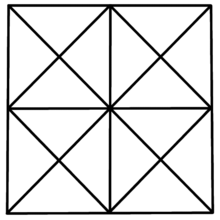Picaria

Picaria is a two-player abstract strategy game from the Zuni Native American Indians or the Pueblo Indians of the American Southwest.[1] It is related to tic-tac-toe, but more related to Tapatan, Nine Holes, Achi, Tant Fant, and Shisima, because pieces can be moved to create the three-in-a-row. Picaria is an alignment game.
There are two variations to Picaria. The first version is simpler with 9 spaces or intersection points, and the second version uses 13 spaces or intersection points. The rules are the same.
Goal
To create a three-in-a-row of one's pieces either horizontally, vertically, or diagonally.
Equipment
A 3×3 board is used for the first version. Three horizontal lines form the three rows. Three vertical lines form the three columns. Two diagonal lines connect the two opposite corners of the board. Additionally, there are four more diagonal lines connecting the midpoints. These four additional diagonal lines is what makes the Picaria board different from Tapatan or Achi. The intersection points are where the pieces are played.
The second version uses a similar board except there are four additional spaces or intersection points to play pieces at. The four additional spaces or intersection points are at the intersection of the four additional diagonal lines with those of the larger diagonal lines.
Each player has three pieces. One plays the black pieces, and the other plays the white pieces, however, any two colors or distinguishable objects will suffice.
Rules and gameplay
- The board is empty in the beginning.
- Players decide what colors to play, and who will start first.
- Drop phase: Each player drops one piece per turn on any vacant space on the board except the center (central intersection point). Players alternate their turns. Pieces cannot move until all three pieces of a player have been dropped.
- Move phase: After each player's three pieces have been dropped on the board, each piece can move one space at a time following the pattern on the board including to the center. Only one piece can be moved per turn.
- Players can create the three-in-a-row at either the drop phase or move phase, and win the game.
House rules
These are rules that you and the other player can agree upon. They are not standard for the game.
- A stalemate where one player cannot make a move is cause for a draw of the game, or a loss to that player.
- Repeating a position three times can be cause for a draw.
See also
References
External links
- http://mathcentral.uregina.ca/RR/database/RR.09.00/treptau1/game11.html
- http://www.gamesmuseum.uwaterloo.ca/VirtualExhibits/rowgames/picaria.html